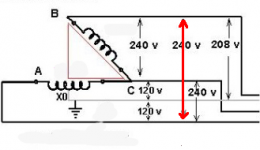What I have experienced and encountered more than a few times over the years is different, I call it the 'open jaw problem' where L-L 240V loads like HID parking lot lighting, computers, copiers etc, connected across the A-B leg (red arrow below) experience enough voltage fluctuation that they just don't work reliably.
For example the first time I ran into this over 20 years ago was building that had a large 3 wire 240V parking lot lighting circuit, all the lights connected A-B would flicker on-off, the banks A-C and C-B were fine.
My coworker at the time did the usual checked connections, replaced the breaker, then upgraded the fixtures, then we swapped lights around moving the phase wires on the breaker.
When the same loads moved to A-C (lighting pot) or C-B (stinger) they worked fine.
Sensitive electronics or even electronic ballasted MH fixtures just would not run reliably on A-B, until the utility made it a full delta.
Which is what I now always recommend when building is converted from industrial to retail/office and they have to keep the 240D (for elevators, roof chillers etc)
View attachment 2564657

